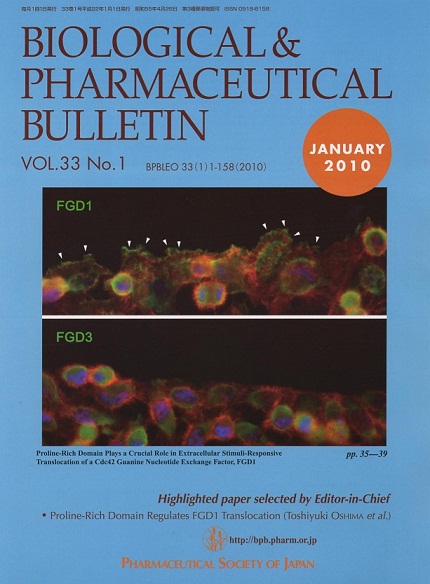33 巻, 1 号
選択された号の論文の32件中1~32を表示しています
- |<
- <
- 1
- >
- >|
Analytical Biochemistry
Notes
-
原稿種別: Notes
専門分野: Analytical Biochemistry
2010 年 33 巻 1 号 p. 122-124
発行日: 2010/01/01
公開日: 2010/01/01
PDF形式でダウンロード (137K)
Biochemistry
Regular Articles
-
原稿種別: Regular Articles
専門分野: Biochemistry
2010 年 33 巻 1 号 p. 1-5
発行日: 2010/01/01
公開日: 2010/01/01
PDF形式でダウンロード (551K) -
原稿種別: Regular Articles
専門分野: Biochemistry
2010 年 33 巻 1 号 p. 6-10
発行日: 2010/01/01
公開日: 2010/01/01
PDF形式でダウンロード (94K)
Molecular and Cell Biology
Regular Articles
-
原稿種別: Regular Articles
専門分野: Molecular and Cell Biology
2010 年 33 巻 1 号 p. 11-17
発行日: 2010/01/01
公開日: 2010/01/01
PDF形式でダウンロード (1450K) -
原稿種別: Regular Articles
専門分野: Molecular and Cell Biology
2010 年 33 巻 1 号 p. 18-21
発行日: 2010/01/01
公開日: 2010/01/01
PDF形式でダウンロード (2042K) -
原稿種別: Regular Articles
専門分野: Molecular and Cell Biology
2010 年 33 巻 1 号 p. 22-28
発行日: 2010/01/01
公開日: 2010/01/01
PDF形式でダウンロード (8356K) -
原稿種別: Regular Articles
専門分野: Molecular and Cell Biology
2010 年 33 巻 1 号 p. 29-34
発行日: 2010/01/01
公開日: 2010/01/01
PDF形式でダウンロード (534K) -
原稿種別: Highlighted paper selected by Editor-in-Chief
専門分野: Molecular and Cell Biology
2010 年 33 巻 1 号 p. 35-39
発行日: 2010/01/01
公開日: 2010/01/01
PDF形式でダウンロード (1401K)
Microbiology
Notes
-
原稿種別: Notes
専門分野: Microbiology
2010 年 33 巻 1 号 p. 125-127
発行日: 2010/01/01
公開日: 2010/01/01
PDF形式でダウンロード (103K)
Pharmacology
Regular Articles
-
原稿種別: Regular Articles
専門分野: Pharmacology
2010 年 33 巻 1 号 p. 40-46
発行日: 2010/01/01
公開日: 2010/01/01
PDF形式でダウンロード (972K) -
原稿種別: Regular Articles
専門分野: Pharmacology
2010 年 33 巻 1 号 p. 47-52
発行日: 2010/01/01
公開日: 2010/01/01
PDF形式でダウンロード (270K) -
原稿種別: Regular Articles
専門分野: Pharmacology
2010 年 33 巻 1 号 p. 53-57
発行日: 2010/01/01
公開日: 2010/01/01
PDF形式でダウンロード (276K) -
原稿種別: Regular Articles
専門分野: Pharmacology
2010 年 33 巻 1 号 p. 58-63
発行日: 2010/01/01
公開日: 2010/01/01
PDF形式でダウンロード (256K) -
原稿種別: Regular Articles
専門分野: Pharmacology
2010 年 33 巻 1 号 p. 64-66
発行日: 2010/01/01
公開日: 2010/01/01
PDF形式でダウンロード (128K) -
原稿種別: Regular Articles
専門分野: Pharmacology
2010 年 33 巻 1 号 p. 67-71
発行日: 2010/01/01
公開日: 2010/01/01
PDF形式でダウンロード (181K)
Notes
-
原稿種別: Regular Articles
専門分野: Pharmacology
2010 年 33 巻 1 号 p. 128-132
発行日: 2010/01/01
公開日: 2010/01/01
PDF形式でダウンロード (503K) -
原稿種別: Notes
専門分野: Pharmacology
2010 年 33 巻 1 号 p. 133-137
発行日: 2010/01/01
公開日: 2010/01/01
PDF形式でダウンロード (949K) -
原稿種別: Notes
専門分野: Pharmacology
2010 年 33 巻 1 号 p. 138-141
発行日: 2010/01/01
公開日: 2010/01/01
PDF形式でダウンロード (111K) -
原稿種別: Notes
専門分野: Pharmacology
2010 年 33 巻 1 号 p. 142-145
発行日: 2010/01/01
公開日: 2010/01/01
PDF形式でダウンロード (204K) -
原稿種別: Notes
専門分野: Pharmacology
2010 年 33 巻 1 号 p. 146-149
発行日: 2010/01/01
公開日: 2010/01/01
PDF形式でダウンロード (255K) -
原稿種別: Notes
専門分野: Pharmacology
2010 年 33 巻 1 号 p. 150-152
発行日: 2010/01/01
公開日: 2010/01/01
PDF形式でダウンロード (227K)
Medicinal Chemistry
Regular Articles
-
原稿種別: Regular Articles
専門分野: Medicinal Chemistry
2010 年 33 巻 1 号 p. 72-76
発行日: 2010/01/01
公開日: 2010/01/01
PDF形式でダウンロード (705K) -
原稿種別: Regular Articles
専門分野: Medicinal Chemistry
2010 年 33 巻 1 号 p. 77-83
発行日: 2010/01/01
公開日: 2010/01/01
PDF形式でダウンロード (1250K) -
原稿種別: Regular Articles
専門分野: Medicinal Chemistry
2010 年 33 巻 1 号 p. 84-90
発行日: 2010/01/01
公開日: 2010/01/01
PDF形式でダウンロード (3065K)
Pharmacognosy
Regular Articles
-
原稿種別: Regular Articles
専門分野: Pharmacognosy
2010 年 33 巻 1 号 p. 91-94
発行日: 2010/01/01
公開日: 2010/01/01
PDF形式でダウンロード (533K)
Biopharmacy
Regular Articles
-
原稿種別: Regular Articles
専門分野: Biopharmacy
2010 年 33 巻 1 号 p. 95-99
発行日: 2010/01/01
公開日: 2010/01/01
PDF形式でダウンロード (198K) -
原稿種別: Regular Articles
専門分野: Biopharmacy
2010 年 33 巻 1 号 p. 100-106
発行日: 2010/01/01
公開日: 2010/01/01
PDF形式でダウンロード (5208K) -
原稿種別: Regular Articles
専門分野: Biopharmacy
2010 年 33 巻 1 号 p. 107-110
発行日: 2010/01/01
公開日: 2010/01/01
PDF形式でダウンロード (632K) -
原稿種別: Regular Articles
専門分野: Biopharmacy
2010 年 33 巻 1 号 p. 111-116
発行日: 2010/01/01
公開日: 2010/01/01
PDF形式でダウンロード (201K)
Miscellaneous
Regular Articles
-
原稿種別: Regular Articles
専門分野: Miscellaneous
2010 年 33 巻 1 号 p. 117-121
発行日: 2010/01/01
公開日: 2010/01/01
PDF形式でダウンロード (118K)
Notes
-
原稿種別: Notes
専門分野: Miscellaneous
2010 年 33 巻 1 号 p. 153-156
発行日: 2010/01/01
公開日: 2010/01/01
PDF形式でダウンロード (140K)
Errata
-
原稿種別: Errata
2010 年 33 巻 1 号 p. 157
発行日: 2010/01/01
公開日: 2010/01/01
PDF形式でダウンロード (15K)
- |<
- <
- 1
- >
- >|
